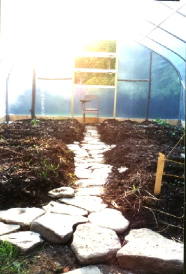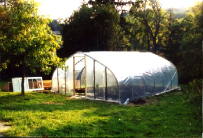

 |
 |
Greenhouse Feature
By Alison Savett
There are 22 varieties of plants growing in Chris Sanford´s greenhouse on Park Street. "All of these plants love cold weather," explained Sanford, a senior art and environmental studies major. "They even do well in freezing temperatures."
This project began last May, when Sanford proposed building a greenhouse next door to the environmental house for her senior project. Once approved by the department, she sent the proposal to ARGUS and applied for the Donaldson Research Grant, which is specifically for environmental studies projects. "ARGUS paid for $250 worth of supplies and a $500 stipend," Sanford said. "The Donaldson Grant paid for the frame and the plastic around the frame. It was around $900 for the structure."
Aside from getting four credits for the project, there was another positive aspect. "Part of the grant is that we get paid for summer work," she explained. "My boyfriend Garrett (Anders-Lauton) and I both got paid for the work we did."
Sanford and Anders-Lauton started the process of building in May, and also made the soil then.
"Alfred State farm let me get horse manure," she stated. "The compost that had been collected from Ade and Powell Dining Halls weighed six tons last semester. So I used the most composted of that."
Sanford used a method called sheet mulching, which consists of laying newspaper on the grass and building the soil up from there. The reasoning for this, she explained, is that the newspaper stops grass from coming up and makes it a lot easier for seeds planted to grow.
Next Sanford planted buckwheat, a legume plant and green manure, which grows nitrogen rich.
"If you pull them out you can see little balls of nitrogen on their roots," she explained. "The roots help process soil. I didn´t mix any of the soil [used for planting] with the clay soil. Then I came back a month later and turned the buckwheat into soil.
Laughing, Sanford mentioned other help she received. "I also had the help of the worms," she said. "It became a really rich soil."
Sanford and Anders-Lauton came back in August and divided the soil into four beds, and added peat moss. After all of the groundwork, she planted the seeds, which took until mid-October and included three varieties of lettuce, along with spinach, endives, radishes and arugala.
"I have a lot of greens," Sanford said. "I have claytonia, also called miner´s lettuce. That´s what the miners ate during the gold rush. I also have minutonia. If you go into Wegman´s you´re not going to find minutonia in a bag." Many of the lettuce varieties, including claytonia and mache, won´t grow in the warm weather, and germinate pretty fast, according to Sanford. She also has grown cabbage, broccoli, mustard greens and kale.
"I hadn´t had a lot of experience growing them, so I tried planting the seeds [how I thought would be] best," she said. "I could probably place them better now. I especially wanted to pay attention to what plants don´t like each other. Leeks like cabbage, but cabbage and tomato don´t grow well next to each other."
This small scale intensive gardening has shown Sanford that all the cold hearty plants seem to get along. Part of the way cold hearty vegetables can live in the winter time is that they turn their starches into sugars, Sanford explained. "I´ve never done anything like this before," she said. "I´m learning something new because it´s not just that the plants store energy, they´re growing too."
After all the work she has put in, Sanford is reaping the benefits of the plants now. "Right now I´m having massive amounts of harvest," she said, holding a basket overflowing with harvested vegetables. Sanford explained that when plants are harvesting in the summertime the planter has to deal with everything immediately. However, the cold hearty plants do not have to be taken care of in such a fashion. "They´ll be sitting there kind of dormant, so I can harvest them at my own pace," she said.
The produce that comes from the greenhouse will be given to people who helped to build it, as well as a few different households in the area. "What I want to do is share the produce with people who come to visit the greenhouse," Sanford said. "I´m hoping to get feedback, maybe share recipes."
Everything is done organically in the greenhouse, and she waters the plants with rainwater collected in a barrel.
"A lot of places in the U.S. rely on farms far away, designated for high yield in terms of acreage," Sanford explained. "All of these strains were developed for easier shipping. It´s not as healthy because they´re using pesticides to keep the veggies looking fresh. Greens go bad very quickly, so it doesn´t make sense to be buying them from California."
The small amount of space that Sanford used is more than enough for a couple of households, she said.
Sanford also has three cold frame beds outside of the greenhouse that she has planted some of the same seeds in for a comparison. Cold frame harvesting is a much smaller, simpler thing to do, she clarified. The plants won´t have the winter harvest, but they can be harvested in the spring. "They are growing slower because it´s more exposed," she stated.
Sanford claimed that there are much cheaper ways to build your own greenhouse, using PVC pipe for example. "You can do it really inexpensively and more practically," she said. "This greenhouse is a lot of work." Historically, the Greeks made greenhouses using sheets of mica, while the French used glass blown bubbles with holes at the top for individual plants, Sanford said.
One of the best things to Sanford about her greenhouse is the continual harvest from lettuce. "To me, that´s a really nice aspect that you are continually harvesting from the same plant," she said.
|
Other Alfred University Links: Email: |
Liberal Arts and Sciences | ENS & Geology
AU Homepage | Campus | Academics | Admissions | Alumni Faculty & Staff | News & Athletics | Research & Outreach | Students |